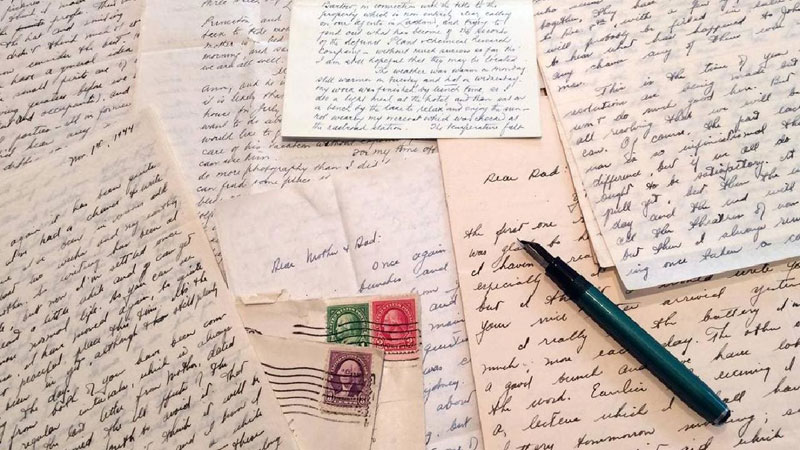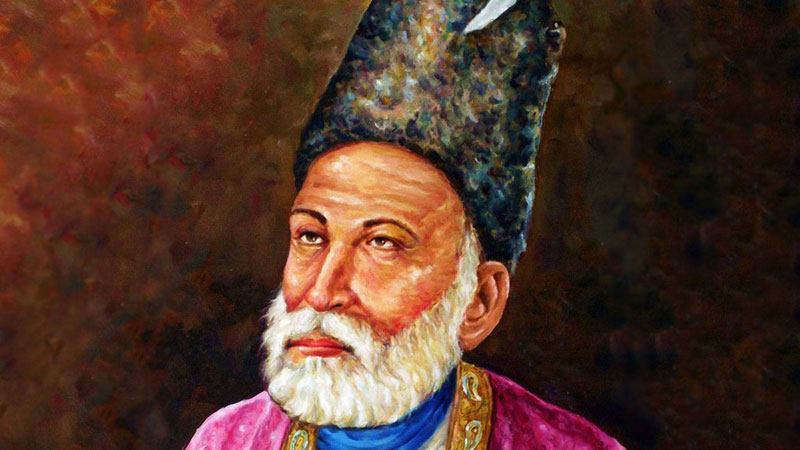 Mirza Ghalib the greatest Urdu language poet said, “Chand Tasweer r Buttan, Naiz Chand Hasenoon Kay Khatoot, Bas Mernay Kay Meray Ghar Say Yay Saman Nikla (A few photographs of beloveds and letters of beauties, that is all which was found in my house after my death)
Mirza Ghalib the greatest Urdu language poet said, “Chand Tasweer r Buttan, Naiz Chand Hasenoon Kay Khatoot, Bas Mernay Kay Meray Ghar Say Yay Saman Nikla (A few photographs of beloveds and letters of beauties, that is all which was found in my house after my death)
So the only precious treasure he had was the photographs of a few beauties and their letters. This indicates the value the letters had in the past. Letter writing is a centuries old tradition and a way of conveying messages of love, sympathy, condolence, breaking news of new arrivals, daily happenings in the family, in short every occurrence, episode or event of daily life used to be conveyed through letters. Even the rulers of vast empires ruled through letters, sending their orders to their designated governors through letters. The modes of dispatching letters were various and in different periods and ages the transporting methods of letters changed. In the distant history, letters were delivered through messengers, travelling miles and miles on horses, camels and in boats, this method of delivery carried lot of risks as at times, the messengers would get killed or robbed on their way to the destination. Pigeons are famous forms of letter carriers all over the world and we find frequent reference of such trained pigeons in the literature of almost all the languages.
References of letter writing are found in holy books as well, such as Hazrat Suleiman (PBUH) writing a letter to Queen of Sheba, Queen Saba and ordering a Hud Hud to deliver his letter to queen Saba. This is a very early reference of letter writing which we find in Quran as well.
As said, earlier letters were the main source of connection between two individuals, groups and families. In fact, they were the binding force of families. When there were no telephones, telegrams, telex, fax, or e mails the only available source of collecting information and welfare about loved ones was the letters. Letters carried so much importance that letter writing was an essential part of curriculums in all educational institutions, and the students were required to write letters sometimes to father or mother some times to a boss and sometimes a business letter in the examination papers with particular emphasis on the contents and style. With the invention of computers and e-mails, the art of letter writing has become dead and lost, and the dot com (. Com) generation is simply unaware of the importance of letters and the excitement and thrill upon receiving a letter one used to get.
In the early days even the word letter was used by children in different games such as playing “Drop the handkerchief” game, “I wrote a letter to my father, on the way I dropped it, The postman came and picked it up, And put it in his pocket. I still remember when once exactly the same happened with me from far away I had written a long letter to my father, but on my way I dropped it somewhere, than I kept on repeating these lines, and to my surprise, my father received that letter. A postman had probably found it on the road, placed a stamp on it and delivered it to the post office. The present generation whom I call the dot com generation has probably never seen a khaki uniformed postman delivering letters on a bicycle or on foot from door to door. After all who can forget PTV’s children programs of the 70’s, Sohail Rana’s Kalioon Ki Mala, was the most popular one.
Dak Babu, Dak Babu, Mera Khat Lay Jana
Nani Amman Ko Day Aana, Pesoon meri Guria Ki Salgerah Hai
(Mr. Postman, M. postman, collects my letter, deliver it to grandma, day after tomorrow is my dolls birthday).
As said earlier, letters were the main source of connection between two individuals, groups and families. In fact, they were the binding force of families. When there were no telephones, telegrams, telex, fax, or emails the only available source of collecting information and welfare
about loved ones was letters
Thus we find in poetry a very frequent use of the word, letter. The letters were an essential part of life. Confining ourselves to Urdu literature there are giants in the art of letter writing, and the first name which comes in mind is definitely that of Mirza Asad Ullah Khan Ghalib, who completely changed the century’s old style and mode of letter writing. He deviated from the conventional way of letter writing, and wrote as if he was talking face to face with a poetic touch and his letters were prompt as if conversing with the reader. Instead of using difficult words he opted for easy words that were used daily. He was a gifted letter writer and his letters were very informal, at times addressing the recipient of the letter directly, deviating from the traditions of using a few word and sometimes few lines just to start the letter. The letters written by Ghalib are without an iota of doubt not only unique but the most read and admired in Urdu literature. The parallel of Ghalib’s style of letter writing is difficult to find in any language of the world. Ghalib’s letters also takes us to the unfortunate happenings after 1857 war of independence which describe the sufferings of people of Delhi and are helpful for the historians who wish to write the history of that war of independence. His letters left a deep influence on literary figures of Urdu.

The exchange of letters between Faiz Ahmed Faiz and his wife Alys Faiz, also speaks of volumes of love between a husband and wife, especially the ones Faiz Sahib wrote from jail, they carry a history along with the love which a father carries in his heart for his daughters
The impact of letters was so immense and deep that the famous Indian Song of 1968, sung by Pankhaj Udass Chitti Ayyi Hai, Baray Dinoon Kay Bad, Hum Bay Watnoon Ko Yad, Watan Ki Mati Ayyi Hai, touched everyone’s heart irrespective of gender, nationality or caste.
The internet and other scientific inventions have no doubt removed the distances and have brought the word’s countries closer but the distance in the hearts and souls has increased and the thrill and excitement of receiving a letter has become nonexistent. I remember when working as a sailor, after long voyages the most awaited commodity was a letter, a letter from my mother and father, from my loved ones. Even if it was late, I would stand and wait on the gangway (Stairs us for climbing the ship) for the shipping company’s agent who would bring the mail while singing the famous 1961 song “Please Mr. Postman” If there is a letter for me in your bag for me
I have been standing here, waiting Mr. Postman so patiently,
For just a card or just a letter.
This was the importance of letters. During my time as a marine cadet, if one got caught with a letter, we had to show twenty pushups for it but we did so willingly simply because of the beauty and joy of receiving a letter or postcard. Now however, the only letter once gets is business-related or from the bank. As a famous poet said,
Utheen Aur Un Kay Khat Hi Parh Dalyeen,
Jinhaeen Tekha Nahin Do Aik Baras Say (Lets read their letters, which we haven’t seen for the last one or two years)
Those letters are now almost obsolete and not even endangered but extinct “species”. The world is tirelessly struggling to save the endangered wildlife species, but unfortunately no serious steps have been taken by literary figures to preserve and save the dying art of letter writing
The writer is a former marine engineer. He can be reached at aamiraqil@gmail.com